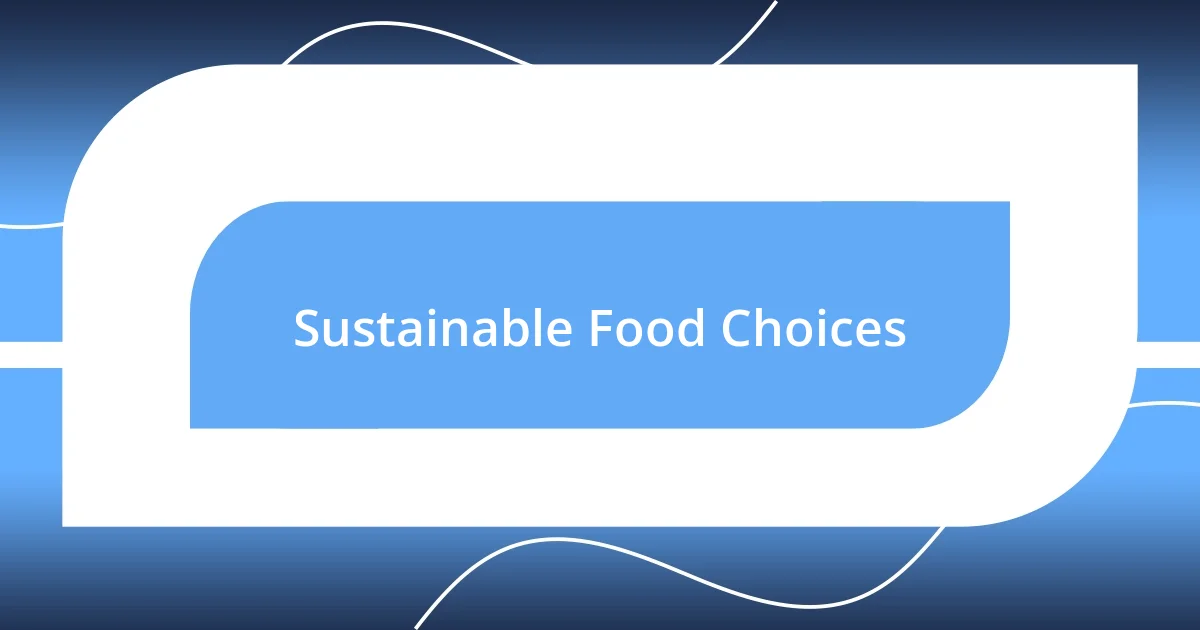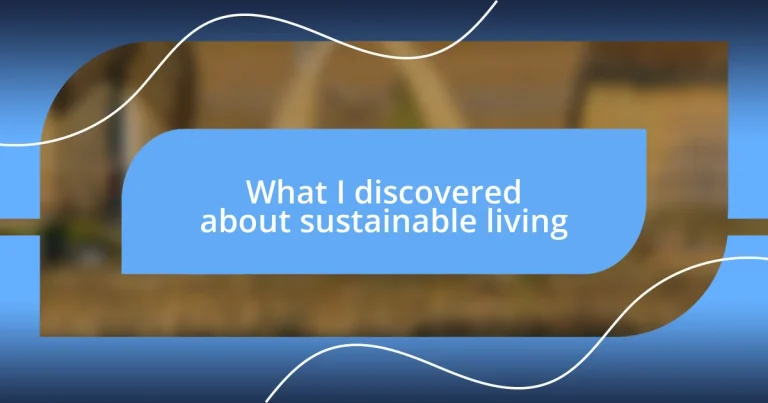Key takeaways:
- Sustainable living involves making conscious choices that benefit both personal well-being and the health of the planet, such as reducing single-use plastics and supporting local markets.
- Key principles of sustainable living include reducing consumption, utilizing renewable energy, and practicing mindful consumption to foster deeper connections with our purchases and the environment.
- Building sustainable communities through collaboration, supporting local eco-friendly businesses, and sharing knowledge can amplify individual efforts and create a larger positive impact.

Understanding Sustainable Living
Sustainable living, to me, feels like a conscious embrace of choices that resonate with the health of our planet. I remember the first time I consciously decided to ditch single-use plastics; it was small, yet empowering. Have you ever felt that rush of satisfaction knowing you’re making a difference, even in a minor way?
The journey of sustainable living is about understanding the impact of our daily choices. When I swapped out my regular grocery habits for local markets, it wasn’t just about fresh produce; it felt like connecting with my community and reducing my carbon footprint. It leads to an important question: how often do we consider the journey of our food before it reaches our plate?
Embracing sustainability isn’t merely a trend—it’s a lifestyle that calls for an emotional commitment. I often reflect on the moments spent gardening, feeling the soil between my fingers, and witnessing firsthand the interconnectedness of all life. Isn’t it amazing how such simple acts can deepen our connection to the earth and awaken a sense of responsibility within us?

Reasons for Sustainable Living
Sustainable living is crucial for ensuring a healthier planet for future generations. I vividly remember a weekend camping trip where I encountered a breathtaking, untouched forest. It struck me how our everyday choices could either preserve such beauty or contribute to its decline. Recognizing that simple actions—like reducing waste and conserving energy—can have profound effects really opened my eyes.
Here are some compelling reasons to embrace sustainable living:
- Environmental Protection: Reduces pollution and conserves natural resources, keeping ecosystems intact.
- Economic Benefits: Saves money through energy efficiency and reduces wasteful spending on disposable items.
- Healthier Lifestyle: Promotes a diet rich in fresh, organic foods, which can lead to better overall health.
- Community Engagement: Encourages connection and collaboration with local businesses and individuals who share similar values.
- Legacy for Future Generations: Ensures that future generations inherit a stable and thriving planet.
By considering these aspects, I’ve realized sustainable living isn’t just about what I cut out—it’s about what I gain: a deeper connection to the Earth and a sense of purpose.

Key Principles of Sustainable Living
Sustainable living is built on a few key principles that guide our choices toward a more eco-friendly lifestyle. One principle I value is the concept of reducing consumption. I recall a time when my wardrobe was overflowing with clothes I never wore. It was liberating to declutter and focus on quality over quantity. Have you ever tried it? You might just find that a minimalist approach not only saves money but also strengthens your sense of personal style.
Another principle that stands out is the emphasis on renewable energy. I made the switch to solar power in my home a few years ago, and I can honestly say, watching the sun power my appliances is a surreal experience. It’s not just about saving on my electricity bill; it’s about contributing to a larger movement towards sustainability. Isn’t it fascinating how harnessing natural resources can empower individuals and communities alike?
Lastly, sustainable living encourages mindful consumption. I’ve become more intentional about the products I buy, focusing on those with minimal packaging and sustainable sourcing. I’ll never forget the satisfaction I felt after purchasing my first eco-conscious gadget; it fueled my desire to support brands that align with my values. How often do we consider the story behind the products we use daily?
| Key Principles | Description |
|---|---|
| Reducing Consumption | Emphasizing quality over quantity helps minimize waste and encourages more thoughtful purchasing habits. |
| Renewable Energy | Utilizing resources like solar power reduces reliance on fossil fuels and promotes energy independence. |
| Mindful Consumption | Choosing products based on sustainability and ethical practices fosters a deeper connection to our purchases. |

Practical Tips for Going Green
When I decided to start my journey toward sustainable living, one practical tip that really transformed my routine was meal planning. I used to find myself wasting so much food—have you ever tossed out that wilted lettuce or forgotten container in the back of the fridge? By planning my meals for the week and making a detailed shopping list, I not only reduced food waste but also saved time and money. It’s amazing how such a simple change can create a more efficient kitchen and nurture a mindful approach to what I consume.
Another effective strategy is swapping out single-use items for reusable alternatives. I remember distinctly walking through a bustling café, and the sight of plastic straws piling up in the trash hit me hard. I made the switch to a reusable metal straw and noticed not just a reduction in my plastic footprint, but a conversation starter that often led to discussions about sustainability. Isn’t it refreshing to influence others through our everyday choices?
Lastly, consider volunteering with local environmental groups. This was a game-changer for me. Joining clean-up events not only connected me with like-minded individuals but also deepened my appreciation for nature. There’s something profoundly satisfying about getting your hands dirty while working side-by-side with others who care for the planet. Have you ever felt the rush of camaraderie while doing something meaningful? It’s a reminder that we’re all in this together, striving for a greener future.

Sustainable Living and Energy Efficiency
Sustainable living and energy efficiency go hand in hand, creating a powerful synergy that benefits both the planet and our wallets. I remember the first time I replaced all my incandescent bulbs with LED ones. The immediate drop in my energy bill was an eye-opener. Have you ever noticed how small changes can lead to significant savings over time?
Investing in energy-efficient appliances has also had a transformative impact on my home. I once inherited an old refrigerator that guzzled electricity like it was going out of style. When I finally made the switch to an Energy Star-rated model, I was blown away by how quietly it worked and how much less power it consumed. It made me think—what legacy do we leave for future generations when we opt for outdated technology?
I’ve also embraced better insulation in my home, a step I initially put off. I vividly recall a chilling winter evening when drafts made my living room feel like an icebox. After adding insulation, the comfort I felt was incredible, as was the noticeable dip in my heating bills. It’s a reminder that being proactive not only enhances our lives but also reduces our energy footprint. Have you ever considered how livable spaces can contribute to a more sustainable lifestyle? It’s enlightening, isn’t it?

Sustainable Food Choices
Sustainable food choices are at the heart of transforming our lifestyles. I vividly recall the first time I ventured into a local farmers’ market. The vibrant colors of fresh produce and the sense of community were intoxicating. It felt rewarding to support local farmers while embracing seasonal ingredients. Have you ever experienced the difference in taste between store-bought and freshly picked fruits and vegetables? It’s like a flavor explosion that reminds me of the earth’s bounty.
Another shift I made was becoming more conscious about my protein sources. I used to rely heavily on meat, often mindlessly grabbing it for convenience. After diving into research on plant-based diets, I started integrating more legumes and grains into my meals. Not only did I discover delicious recipes, but I also felt lighter and more energized. Have you thought about how much impact your plate can have on the planet? The shift towards plant-based options can significantly lower greenhouse gas emissions and water usage.
Lastly, I learned the importance of understanding food labels and choosing products with minimal packaging. I remember feeling a sense of accomplishment when I started buying in bulk, filling my reusable containers rather than opting for pre-packaged items. The experience was liberating! It made me realize that being mindful about my purchases not only benefits the environment, but also fosters a more intentional approach to what I consume. How often do we pause to consider the journey our food takes before it reaches our table? Embracing sustainable food choices truly opens up a new perspective on our daily habits.

Building a Sustainable Community
Building a sustainable community is about fostering connections and collaboration among individuals who share common values. I remember attending a neighborhood meeting where we brainstormed ways to reduce our collective waste. It was encouraging to see how passionate everyone was about finding practical solutions, like organizing clean-up campaigns or starting a community garden. Have you ever felt the power of joining forces with others to create a positive impact? It’s energizing!
One of the most rewarding aspects of building a sustainable community is seeing diverse initiatives come to life. I participated in a local workshop focused on composting, which opened my eyes to the potential of repurposing organic waste. Learning together not only strengthened our bonds but also inspired us to take action in our own homes. Isn’t it fascinating how knowledge sharing can lead to a ripple effect in adopting sustainable practices?
Moreover, the role of local businesses in this journey shouldn’t be underestimated. When a nearby café began offering discounts for customers who brought their own cups, I felt a spark of hope. It was a small gesture, yet it ignited a movement among vendors and customers alike, fostering a culture of sustainability. Have you considered how supporting eco-friendly businesses can contribute to a larger mission? Every purchase becomes a vote for the kind of community we want to build together.












